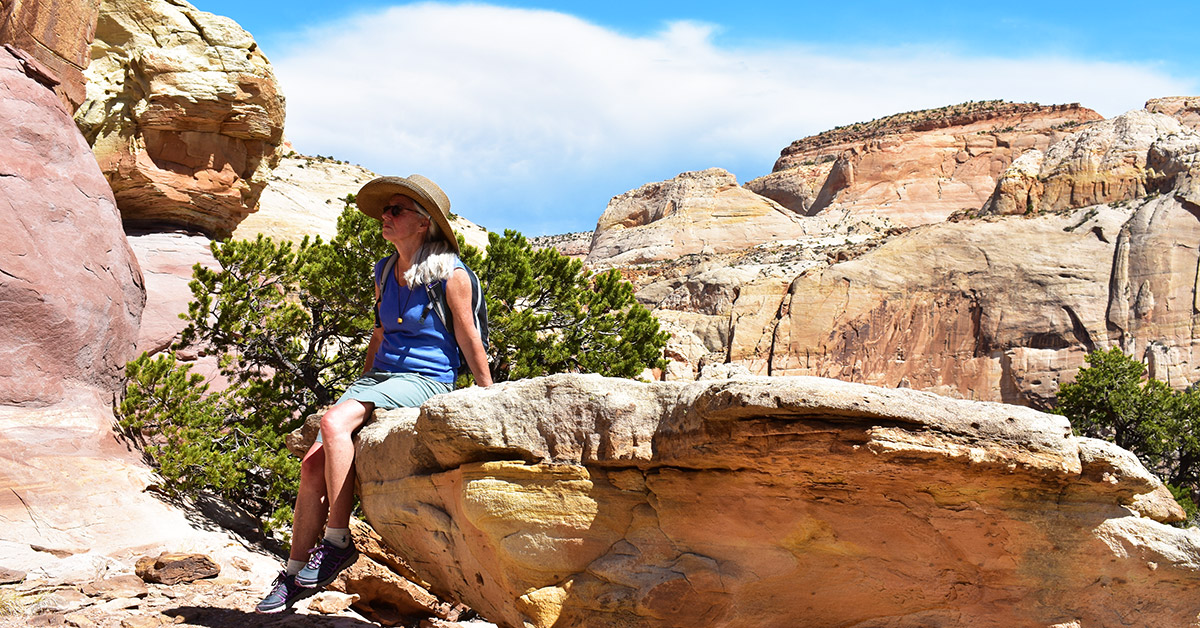
I first came to Utah in 1982, planning to stay a couple years. Like so many best-laid plans, my life proceeded to go its own way. What first caused me to forget my intention to leave Utah was the landscape, both the ever-so-accessible alpine beauty of the Wasatch and the otherworldly landscapes in the south. As time passed, the community I’ve come to love solidified my roots here.
In the ‘80s, I hiked every single weekend in the spring, summer and fall, and camped a dozen times a year. I especially loved hiking on slickrock and hopping boulders. In my 20s, 30s and 40s, I took the ease I felt in boulder hopping for granted. Many years of yoga practice helped me maintain agility and balance. The ease of moving in this body was pure joy.
As I entered my mid- to upper 50s, I began to notice the deer-like agility I’d always enjoyed was turning into the lumbering gait of a desert tortoise. By my late 50s, lifting my legs to get into my car without using my hands was impossible. Needless to say, hopping boulders was a bittersweet memory.
Two hip replacements later, basic function returned, but boulder hopping still eluded me. Since my hip surgeries, I’ve practiced yoga and walked for 30 minutes at least five times a week. I’ve shifted the physical focus in my asana practice to balancing stability and mobility, rather than focusing primarily on becoming ever more flexible. As a result, my hip and sacroiliac joints feel stable and pain-free. But the agility I once enjoyed just hadn’t returned. I assumed that this is how it would be for the rest of my life.
Then my partner and I took a trip to Capitol Reef National Park over Labor Day weekend. We chose to take a moderate hike to the Golden Throne. Toting a backpack, water bottle, camera and a couple lenses—a fair amount of weight—I set off on the trail. The first time I saw a 15-inch-high boulder in my path, I scanned for a handhold to help me negotiate it. Instead, I scrambled up onto it like a champ. Easy. For the rest of the trail, my body negotiated any and all boulders with ease, just like the old days.
Yoga and Strength Training
So what changed? After recommendations from several doctors, a massage therapist and an osteopath at Huntsman Cancer Institute, I began the “Power Program,” a strength-training program offered by their Wellness Center, last April. It took some convincing for me to try it. Steeped in the idea that yoga and walking should be enough for me to regain my strength after my hip replacements, I resisted for more than a year. Now I’m sold.
The Power Program gives Huntsman patients access to their gym equipment and to the knowledgeable personal trainers in the hospital’s Wellness Center. Participants receive a physical evaluation from a doctor and then can work with a personal trainer for a fee that’s affordable to anyone.
Even without the added complications of losing strength due to degenerating hip joints, all our bodies begin to lose muscle mass as we age. Sarcopenia, loss of muscle mass and strength, is a normal condition associated with aging. Left to their own devices, this is what our bodies will do.
Fortunately, loss of muscle mass can easily be reversed. Studies show that resistance training builds strength and muscle mass, increases bone density (therefore reducing the risk of osteoporosis), and reduces the signs and symptoms of chronic diseases such as arthritis, type 2 diabetes and heart disease. I noticed a difference in my strength and agility after just three sessions.
Yoga and Strength Training Can Be a Meditation
If I practiced one of the more aerobic styles of yoga asana, perhaps I would have been able to regain my strength through my regular practice. But that is not why I practice yoga asana. I practice asana for the mind-body ease and calm for which the practice was originally intended.
While I do understand that asana practice can build agility and strength, these are a side benefits. Asana practice was designed to calm the nervous system. When I studied with him in India, B.K.S. Iyengar said (and I’m paraphrasing), “The purpose of asana practice is to create a calm, peaceful environment for the mind.”
So as I enter my 60s, I realize I need to add another practice to my life to maintain physical self-care. No longer can I take agility and strength for granted. But that’s perfectly fine. After my asana practice, my body and mind feel clean, calm and clear. After my Power Program sessions, my naturally loose-knit body feels cohesive and my mind feels awake and energized. The combination of yoga and strength training balances me body and mind.
Are the repetitions boring? Sometimes, but only when I’m not giving them my full attention. Practiced with mindfulness, strength training—like everything else—becomes an opportunity to investigate and learn about all aspects of our mind-body experience. I can’t say it feels as good as my yoga asana does in the present moments of practice. But I believe that strength training complements my yoga practice and is, in a way, a meditation all its own.
